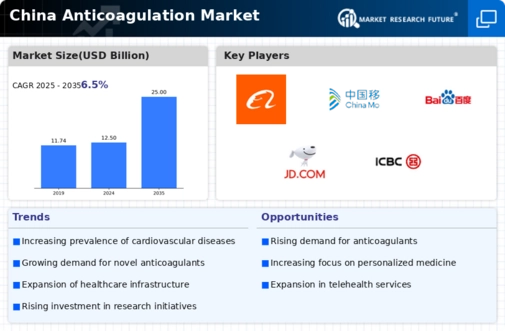Increasing Aging Population
The aging population in China is a critical driver for the anticoagulation market. As individuals age, the risk of developing cardiovascular diseases and thromboembolic disorders rises significantly. According to recent statistics, approximately 18% of China's population is over 60 years old, a figure projected to increase in the coming years. This demographic shift is likely to lead to a higher demand for anticoagulant therapies, as older adults are more susceptible to conditions requiring anticoagulation. Furthermore, the healthcare system is adapting to this trend by enhancing access to anticoagulant medications, thereby expanding the market. The growing awareness of the importance of managing blood coagulation effectively among healthcare providers and patients further supports the expansion of the anticoagulation market in China.
Rising Awareness and Education
There is a growing awareness and education regarding the importance of anticoagulation therapy in China, which serves as a significant driver for the anticoagulation market. Healthcare professionals are increasingly recognizing the need for effective anticoagulation management, leading to improved patient outcomes. Educational campaigns aimed at both healthcare providers and patients are being implemented to highlight the risks associated with thromboembolic events and the benefits of anticoagulant therapies. This heightened awareness is likely to result in increased prescriptions and adherence to anticoagulation regimens. Furthermore, as patients become more informed about their treatment options, the demand for anticoagulants is expected to rise, thereby positively impacting the market.
Emerging Market for Novel Anticoagulants
The emergence of novel anticoagulants is significantly influencing the anticoagulation market in China. These new agents offer advantages over traditional anticoagulants, such as fixed dosing and fewer dietary restrictions, making them more appealing to both healthcare providers and patients. The market for novel anticoagulants is projected to grow as clinical evidence supporting their efficacy and safety continues to accumulate. Additionally, the increasing prevalence of conditions requiring anticoagulation, such as atrial fibrillation, is likely to drive demand for these innovative therapies. As healthcare systems in China adapt to incorporate these novel agents, the anticoagulation market is expected to experience substantial growth.
Technological Advancements in Diagnostics
Technological advancements in diagnostic tools and monitoring systems are playing a pivotal role in shaping the anticoagulation market in China. Innovations such as point-of-care testing and remote monitoring devices enable healthcare providers to manage anticoagulation therapy more effectively. These technologies facilitate timely adjustments to treatment plans based on real-time data, enhancing patient safety and treatment efficacy. The integration of advanced diagnostic tools into clinical practice is likely to lead to increased patient compliance and better management of anticoagulation therapy. As a result, the market is expected to expand as healthcare providers adopt these technologies to improve patient outcomes and streamline treatment processes.
Government Initiatives and Healthcare Policies
Government initiatives aimed at improving healthcare access and quality in China are significantly influencing the anticoagulation market. The Chinese government has implemented various policies to enhance the management of chronic diseases, including cardiovascular conditions. For instance, the Healthy China 2030 initiative emphasizes the prevention and treatment of cardiovascular diseases, which directly correlates with the need for anticoagulant therapies. Additionally, the inclusion of anticoagulants in the National Reimbursement Drug List (NRDL) has made these medications more accessible to patients, potentially increasing their usage. As a result, the anticoagulation market is expected to benefit from these supportive policies, which aim to reduce the burden of cardiovascular diseases and improve patient outcomes.

















Leave a Comment